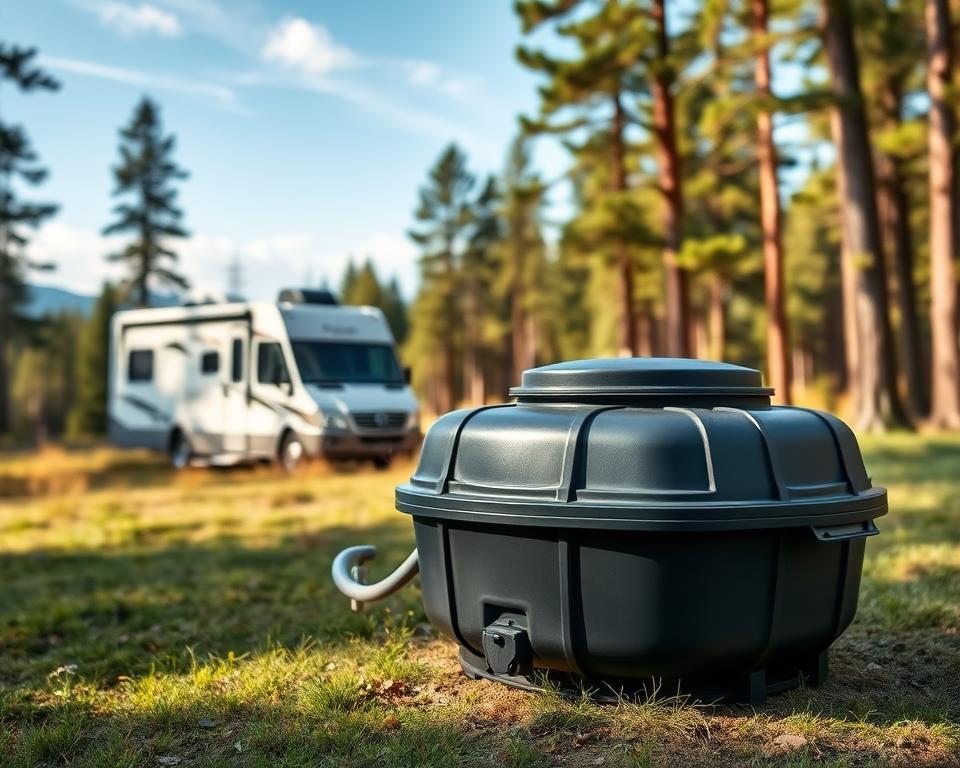RV Sewer Pump Guide: Key Maintenance Advice
Did you ever ponder the mechanics of your camper’s waste disposal system? Knowing the ins and outs of your RV sewer pump can avoid mishaps, improving your outdoor adventures. It’s about controlling waste smoothly and dodging noxious odors. Through this guide, you’ll discover vital maintenance techniques for RV tank pumping service near me. Each crafted to maintain your sewage system’s optimal function.
Learning About Your RV Sewer Pump System
The camper sewage pumping setup is crucial for waste management, making RV outings more convenient. It comprises two principal tanks: the sewage holding tank for solid waste and the grey water tank for water from wash stations. Distinguishing between these tanks is key to avoid clogs and keep your RV functioning efficiently.
An RV waste grinder is a widely used solution for sewage handling. It pulverizes solid waste into tiny bits, easing disposal. In contrast, a traditional camper sewage pump is available. It smoothly moves waste without shredding, for those choosing a simpler option.
Understanding your RV’s sewer pump system is key to preventing problems and ensuring clean inspections. Using the system properly can prevent messes, uplifting your outdoor adventures.
Why Consistent Upkeep Matters
Upkeeping your RV sewer pump is imperative for a seamless trip. Without proper care, you may run into odors, clogs, or backups. These problems can spoil your road trips.
Scheduled upkeep prevent such problems and prolong your system’s life. By inspecting hoses and seals, you improve efficiency. A regularly checked RV sewage pump secures clean waste handling, letting you enjoy seamless excursions.
Consistent attention also yields financial savings over time. Neglect can cause costly breakdowns, requiring high-cost fixes. Committing to regular maintenance keeps your motorhome in peak form, preserving money long term.
How Frequently to Service Your RV Septic Tank?
Determining the proper interval to service your RV Septic tank is vital for its upkeep. It’s best practice to pump every 3–5 days during use. For short trips, after-journey servicing may do the trick.
Frequency depends on various elements. Tank capacity and usage level are critical. Ideally pump when it reaches two-thirds full. This helps support uninterrupted discharge and ward off backups.
Observing your RV Septic tank levels is vital for a stress-free outing. Ensure proper management of your camper’s waste to stop issues while traveling.

Top Techniques for Tank Drainage
Correctly draining RV tanks is vital for your motorhome’s sanitary condition and functionality. Always empty first the black water tank to let the grey tank liquid rinse leftover solids. This technique prevents clogs and ensures seamless flow.
Choose a high-quality drain hose for disposal. A heavy-duty hose avoids leaks and fastens connections. Attach a tank rinser for a thorough rinse, using water pressure to remove remaining debris, upgrading cleanliness.
Full discharge prevents residue buildup, stopping foul odors and potential issues. To maintain an well-functioning sewage system in your motorhome, implement these guidelines:
- Regularly use a tank treatment to control odors and break down waste.
- Keep an eye on fill levels to avoid overflows.
- Inspect your RV waste pump regularly for clogs and wear.
- Flush your tanks thoroughly monthly or bi-monthly, even during infrequent outings.
Implementing these practices enhances your sewage system’s longevity and performance, ensuring enjoyable travels.
Stopping Stench and Obstructions
For a nice outing, warding off smells is crucial. Maintain adequate water level to aid in decomposition, stopping unpleasant odors. Also, using RV-safe toilet paper helps prevent clogs, keeping the system running smoothly.
For enhanced refuse control in campers, try enzyme-based tank treatments. These effectively break down waste, simplifying maintenance. Check the vent line often to keep air moving freely in the plumbing system.
Cautious flushing is crucial to avoiding tank issues. Avoid flushing wipes, feminine products, and paper towels. These non-degradable objects can cause major clogs. Adhering to these guidelines helps maintain a tidier camping environment.
Care Recommendations for RV Waste Pumps
Maintaining your RV’s sewer pump system is crucial for trouble-free travels. Verify seal condition frequently to prevent leaks. Leaky seals can cause unexpected spills, harming your RV.
To remove stench and maintain cleanliness, sanitizing is crucial. Perform a deep clean every few months to prevent buildup, ensuring the system performs reliably. These steps are imperative for maintaining a portable RV pump, promoting durability and efficient operation.
Greasing valve components is another vital task. It helps ward off seepage and enhance functionality. Checking sensor accuracy is vital for precise measurements, preventing run-ons and unexpected pump issues. Regularly reviewing these points makes your RV adventures spotless and more enjoyable.
When to Call in a Pro for Pump-Out
Identifying septic problems ahead can protect you from costly repairs. A primary clue you need a expert emptying is slow draining. When sinks and toilets take longer to clear, it often points to blockages. It suggests your system may be clogged.
Persistent odors are another clear sign of sewage troubles. Bad odors lingering despite cleaning suggest trapped waste. It’s crucial to check the transparent elbow fitting when dumping waste. Remaining waste visibility signals it’s time for expert emptying.
Technicians utilize jet machines to break up hard obstructions efficiently. Ignoring these warnings can snowball major problems. Therefore, it’s vital to seek help immediately when issues arise.
| Indicators of Sewer Trouble | Suggested Steps |
|---|---|
| Slow Draining | Inspect for clogs; arrange professional pump-out |
| Persistent Odors | Inspect fittings; schedule pump-out |
| Obvious Debris | Call pro for deep cleanse |
Choosing the Right RV Macerator Pump
When evaluating an RV macerator pump, assess its volume handling, durability, and compatibility with your RV’s size. A reliable macerator is key for effective waste grinding. This is especially vital for RVs requiring frequent disposals. High-end pumps enhance sewage handling, ensuring a better travel experience.
Different models cater to different preferences. For an informed decision, focus on these main points:
- Capacity: Confirm volume capability suits your needs.
- Durability: Opt for models built to endure travel demands.
- Ease of Use: Select pumps with intuitive controls.
- Compatibility: Verify the pump fits your RV plumbing.
Taking time to compare when choosing an RV macerator pump improves travel enjoyment and ensures efficient pump performance.
Troubleshooting Your RV Sewer Pump
Proper troubleshooting for your RV sewer pump is key in resolving common sewage issues before they worsen. If you notice slow drainage, unplanned backflows, or persistent odors, take immediate action. These are definite clues of malfunction requiring attention.
Begin by examining the pump, its connections, and hoses. Look for any clogs that could slow flow. Ensure inlet and outlet fittings are properly connected. Also, verify the pump’s power supply for consistency.
If basic checks fail to reveal the issue, listen to the pump’s sound. A unit that’s abnormally loud or abnormally quiet may have internal damage. Also, inspect for leaks, as these can exacerbate sewage problems. With these troubleshooting steps, many RV owners identify and resolve issues early, avoiding costly repairs.
Long-Term RV Sewer Pump Care
For extended service life, commit to regular sewer pump upkeep. Sanitize the system consistently to prevent clogs. Establish and follow a maintenance routine, keeping everyone informed of their roles. This markedly improves your waste system’s lifespan.
Training yourself and others on correct flushing habits is key. This avertss issues and fosters shared responsibility. The result benefits both users and the sewer system.
- Inspect plumbing and hoses periodically
- Maintain clear filter screens
- Book expert service once a year
- Select suitable additives
Abiding by these practices prolongs your camper’s sewage system’s durability and keeps it healthy, making travels more enjoyable.
In Closing
Maintaining your camper’s waste pump properly is key for seamless camping adventures. Regular attention to RV sewer system maintenance markedly cuts problem risks, letting you engage in the journey. By knowing your system and using reliable sewage methods, your trips will be free of waste management woes.
Applying the critical tips from this guide improves RV waste management and uplifts your travel comfort and safety. Keep your sewer pump in top shape by following best upkeep practices and addressing potential issues promptly.
Being watchful and well-informed about your RV sewer system yields benefits. It secures homely comforts while exploring. Cheers to joyous and untroubled journeys!
Common Queries
How can I tell it’s time to empty my RV Septic tank?
Pump the RV Septic tank when it hits 66% capacity.
How do black and grey tanks differ?
The black tank holds toilet waste. Whereas, the grey tank collects water from sinks and showers.
How often should I maintain my RV sewer pump system?
Perform maintenance every few months.
What treatments should I use on my RV sewer system?
Use enzyme-based treatments safe for RVs.
How to keep my camper’s sewer lines clog-free?
Avoid flushing non-biodegradable items.
How to know if I need expert pump-out?
Blockages, foul scents, or tank overflow warrant expert service.
Making your RV macerator pump work better?
Ensure capacity and compatibility.
What should I check during a deep clean of my RV sewer system?
Clean sensors and lubricate valves.
Maintaining my RV sewer system over time?
Inspect hoses, treat tanks, and schedule annual pro servicing.
Septic pumping frequency for heavy RV use?
Schedule pump-outs every 3–5 days.


